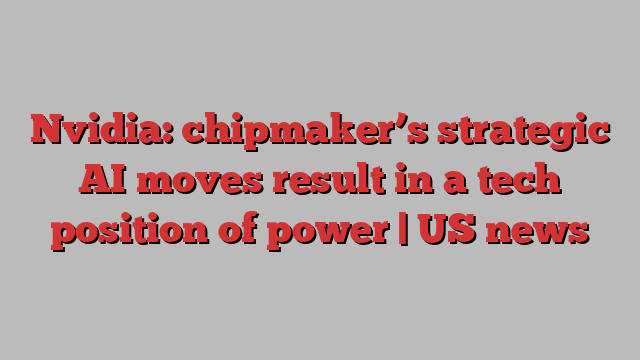
Nvidia saw its valuation soar to $1tn on Tuesday, making it the fifth most valuable American company and one of the first major corporate beneficiaries of the hype around AI.
The chipmaker has been a major and in some cases dominant player in several industries for years. But no development has raised its profile – and its potential windfall – as much as the current excitement around generative AI.
Nvidia has been around for 30 years. The company got its start in 1993 building graphics processing units (GPUs) for video games. It came to command the space, and over time expanded its operations by repurposing those chips to help power automated driving systems such as those in Tesla vehicles as well as data centers. Today, Nvidia’s chips power many of the systems households around the world interact with on a daily basis.
While competing chipmakers such as Intel, Micron Technologies and Advance Micro Devices (AMD) spent the past years battling for marketshare in spaces with existing demand like powering data centers, Nvidia invested in building and developing chips that can power various AI use cases.
The strategy means the company now has the upper hand, said Wedbush Securities managing director and senior equity research analyst Dan Ives. “In terms of scale, scope and the ability to integrate the data, Nvidia is essentially the only game in town.”
To build ChatGPT, OpenAI relied on thousands of Nvidia chips, according to Reuters. Elon Musk, who has a long history of partnering with Nvidia to power Teslas, has also acquired Nvidia chips for his own AI startup, according to the Financial Times.
In the May earnings call that sparked Wall Street’s enthusiasm for the company, Nvidia CEO and co-founder Jensen Huang said the firm expected to bring in $11bn in revenue in the upcoming quarter – $4bn more than Wall Street expected the chipmaker to make.
Industry experts think Nvidia will see its profits continue for quite a while. “AMD, Micron and [Taiwan Semiconductor Manufacturing Company] will clearly be beneficiaries but Nvidia built the house,” Ives said. “Now everyone’s coming because the use cases for generative AI because of ChatGPT have caused a tidal wave of demand for these chips. The demand is on the enterprise and on the consumer side, and, down the road, autonomous self-driving.”
“Teaching computers to become intelligent requires extremely powerful processing capacity, said Geir Lode, head of global equities at Federated Hermes Limited, an investment firm. “In 2021, computer gaming drove revenues and earnings higher. Now artificial intelligence is the next supercharged growth area, and we expect this is just the beginning. We know growth will be there, but valuations can be hard to justify.”
Though Nvidia is a big name in the industries it operates in, many consumers may be less familiar with it. That’s partly by design. Though the company plays a crucial role in powering systems that consumers around the world rely on, it operates in the background and allows the company that owns the consumer interface or the actual product that people purchase or interact with to shine.
Still, every few years, excitement around certain technologies thrust the company into the spotlight. At times, that’s hurt the company: mass demand for Nvidia chips from crypto miners, for instance, led the company to lower its revenue projections to $100m for the first quarter of 2020 due to a chip shortage and higher prices.
But in the case of AI, Nvidia seems more prepared. On the earnings call, company chief financial officer Colette Kress said the company has already started to buy a supply of chips in preparation for continued spikes in demand in the second half of the year.
The magnitude of the current bump in demand and expected revenue is “astonishing”, Lode of Federated Hermes Limited said.
In the past, demand for Nvidia chips sparked by a hype around a new technology would subside over time. For example, Nvidia was the chipmaker of choice for many companies testing and developing self-driving cars. But as companies grappled with the costs of the chip and the desire to control more of their supply chain, some moved away from using Nvidia chips. Tesla and General Motor’s Cruise, notably, opted to develop their own.
Although Ives expects other companies to build these chips over time, he says it will likely be several years before they’re able to match the scale and scope that Nvidia has today. “I think the first phase is that Nvidia is going to be the foundation of AI, but in the next two to three years, I wouldn’t be surprised if Apple, Google and potentially others don’t try to build their own chips,” he said.
“Others have tried to build and fend off Nvidia but there have been many endeavors with little results,” Ives continued. “I think AMD is the closest to what’s going to be a beneficiary potential with its relationship with Microsoft.” But Jensen and Nvidia have been so many years ahead of any other chip player, Ives said, that it makes it challenging for others to catch up. “Many in the chip world were skeptical around AI, whereas Nvidia jumped into the deep end of the pool – they built it and they were waiting for others to come,” he said.
If players such as Google and Apple begin building and selling chips to power AI systems, one advantage Nvidia has is its existing partnerships with companies across industries. Unlike Google and Apple, Nvidia has established trust as a supplier that is not interested in taking over or controlling the consumer interface.
Nvidia is the Switzerland of AI, Ives said. “There’s less trust issues from the software companies because they’ve always stayed a chip player.” As for the big tech stalwarts? “They’re the big bad wolf, you don’t want their tentacles in your enterprise,” Ives said.